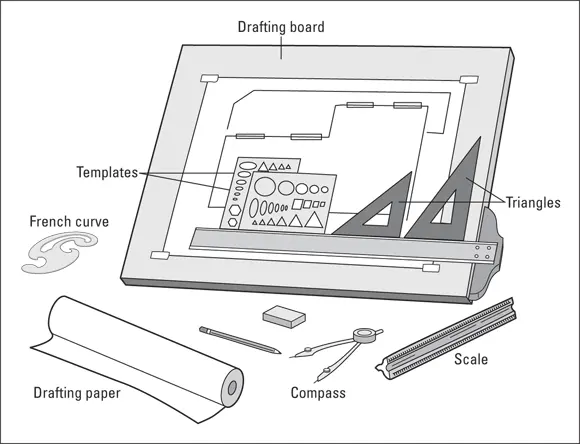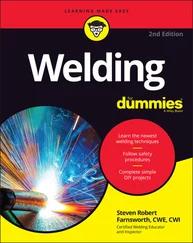
© John Wiley & Sons, Inc.
FIGURE 2-4:You can draft your garden plan, but here are some tools that can help.
If you want, you can also use photography to help sketch out your plans, Photograph panoramic sequences of every part of your property, as well as external features (such as views) you may want to enhance or hide.
Making your drawing match your dream
After completing the initial drawing of your yard or garden plot to your satisfaction, you can move forward and add the elements for your garden plan. Here are some recommendations:
1 Gather any pictures you’re using for inspiration, and prepare a list of your main goals, assets, and limitations.Go to the earlier section in this chapter, “ Evaluating What You Already Have,” for advice on looking at your yard’s challenges and advantages. The earlier section, “ Getting Ideas for Your Garden Space,” can help you focus on your gardening goals.
2 Study your current plan carefully.Decide which features you want to incorporate into your final plan, which ones you want to highlight, and which ones you want to downplay or remove.
3 Place a piece of tracing paper over your plan.
4 Use a pencil and sketch in or leave out various features and designs.Try hard to stick to your theme or overall vision and attempt to be organized (see the section, “ Zeroing In on Your Ideal Garden Style,” earlier in this chapter for details on themes). When designing your garden plan, you don’t have to get bogged down in details, listing every plant by name. Instead, “sun-loving perennials,” “blue and yellow bed,” or “pots of annuals” may suffice.
 When I make my garden plan, I like to use several sheets of tracing paper. I use one sheet for each type of plant: one for trees and shrubs, one for bulbs, one for annuals, and one for perennials. I lay over the base plan with all these tracing papers on poster board; it contains the fixed existing features like the house, trees, and hardscapes. Using multiple sheets make it easier to see how everything will go together.
When I make my garden plan, I like to use several sheets of tracing paper. I use one sheet for each type of plant: one for trees and shrubs, one for bulbs, one for annuals, and one for perennials. I lay over the base plan with all these tracing papers on poster board; it contains the fixed existing features like the house, trees, and hardscapes. Using multiple sheets make it easier to see how everything will go together.
After all the elements you’ve planned for are in place, take a good look at them to make sure the overall drawing matches the initial image of the dream garden you had in your head. If something looks awkward or looks like it needs to be moved or changed in any way, do so! Keep changing that drawing (and redrawing it if necessary) until you have a final plan that satisfies you. Only when your final plan is in your hands should you prepare yourself to move on to the next step.
Defining key areas to start
With your sketched yard in hand, your next step is to decide which area you want to start with and to roll up your sleeves. As I repeatedly advise, tackling everything at once isn’t easy and often isn’t realistic or affordable. Break big projects down into manageable pieces, and do them one at a time.
Like rooms in a house, a garden area has four major elements. And as in building a house, going from the ground up is best. Tackle the four major elements in this order:
1 FloorLawn grass, a groundcover, paving materials, or good, plantable soil
2 WallsSupplied literally by a wall of your house; by a fence, hedge, or trellis; or by backdrop of evergreens or shrubs of some kind
3 CeilingCan certainly be open sky but may also involve an umbrella, awnings, overarching tree or large-shrub branches, or a pergola with or without a cloak of plants
4 FurnitureLiterally tables and chairs and benches and the like, but also major containers or garden ornaments and decor Don’t go overboard with garden gnomes and pink flamingos. Limit yourself to one or two ornaments and keep the focus on the sense of space and the living parts of your garden.
Getting Professional Help
Getting a garden plot ready, especially a large one, isn’t easy, and I don’t pretend that it is (I have better uses for my creative energy, such as pretending I’m in Hawaii). If starting the process makes your head reel, or if you don’t have confidence in your design sense, don’t worry. Others can do it for you. They can do everything, in fact, from planning on paper to purchasing to digging the holes and planting the plants. You can confer with or hover over them, or wind them up and let them go. You can even stop them at the point where you want to take over.
Also, be honest with yourself when a project is beyond your ability, unsafe for you, or too time-consuming to undertake on your own. Under such circumstances, go ahead and hire a contractor. The following sections examine four options you may consider when hiring a professional. I also include important tasks you can do when hiring a pro.
Considering different professionals
Here are four choices for hiring a professional:
Landscape architects, landscape designers, and garden designers: Landscape architects, landscape designers, and garden designers are all professionals, trained in every facet of planning and realizing an outdoor plan. Their scope goes beyond regular backyard gardens or even the landscaping of an estate; many of these folks are capable of laying out a resort, college campus, public park, and so on. They can cope with topography and know how to analyze a site completely, down to its soil and light and existing vegetation. They can design walkways and decks and such in savvy and attractive ways. They can then draw up a design or several alternatives.All concerns about cost aside, hiring someone like this to do your yard is a marvelous investment. These professionals tend to notice and address elements and problems you may not have thought of; they propose appropriate and attractive solutions; and they have wide knowledge of both plant material and hardscape components. They’re the full planning package.
Landscape or general contractors: They’re the folks who are usually called in to actually install the job. They do the heavy lifting. Don’t be afraid to ask someone for help to create your vision: somebody strong enough, experienced, and knowledgeable; somebody certified, bonded, and insured as well. A reputable contractor has no problem demonstrating her qualifications. Getting help isn’t wimpy; it’s only good sense.Let someone else do the hard jobs and do them safely and correctly the first time. These folks can install all your residential hardscape needs like walks and walls. Save the fun and creative parts for yourself.
Master gardeners: A master gardener isn’t someone you hire but rather someone you can consult and consider a resource. Master gardeners have to follow a certification process. Throughout the country at Cooperative Extension Service offices (staffing and budgeting permitting, I should add), classes train avid home gardeners or anyone else who’s interested in horticulture. Candidates take a core course, often in the fall or winter when life outdoors is less busy.The hours and courses required for certification vary from office to office, state to state. Getting certified doesn’t make a person an expert; it just shows that he or she has made a commitment to learning more about and serving in the local horticultural scene.To find a master gardener, call the nearest office of the Cooperative Extension Service. You can search online or go to https://ahsgardening.org/gardening-resources/master-gardeners/ .
Professional horticulturists: The term professional horticulturist is somewhat nebulous, but in general these professionals are university-trained folks with an undergraduate or graduate degree in some form of plant science, usually horticulture. They usually have a broad range of knowledge about plants. Their training is science based and includes courses on soils, chemistry, biology, botany, plant physiology, entomology, plant pathology, landscape design, as well as specific courses on various aspects of horticulture. Most of them work in professional capacities at large nurseries and greenhouses. They may or may not have a background in garden design.
Читать дальше


 When I make my garden plan, I like to use several sheets of tracing paper. I use one sheet for each type of plant: one for trees and shrubs, one for bulbs, one for annuals, and one for perennials. I lay over the base plan with all these tracing papers on poster board; it contains the fixed existing features like the house, trees, and hardscapes. Using multiple sheets make it easier to see how everything will go together.
When I make my garden plan, I like to use several sheets of tracing paper. I use one sheet for each type of plant: one for trees and shrubs, one for bulbs, one for annuals, and one for perennials. I lay over the base plan with all these tracing papers on poster board; it contains the fixed existing features like the house, trees, and hardscapes. Using multiple sheets make it easier to see how everything will go together.










